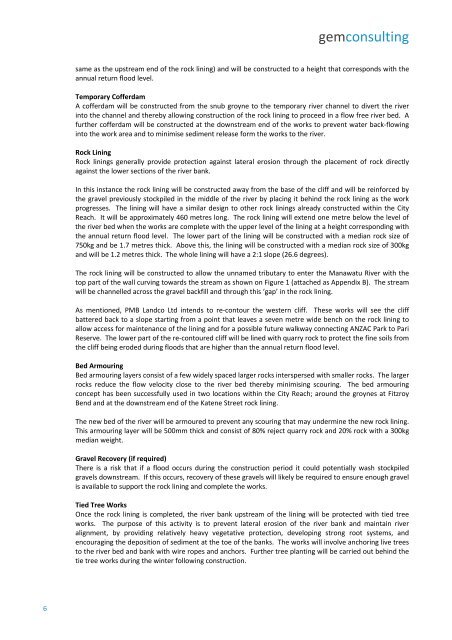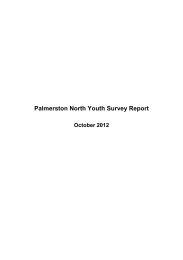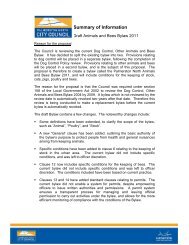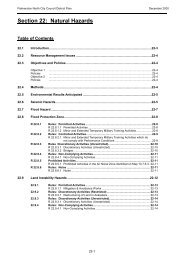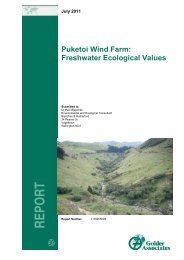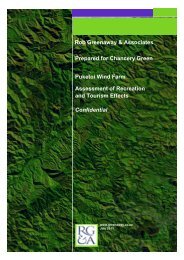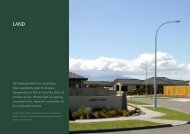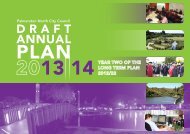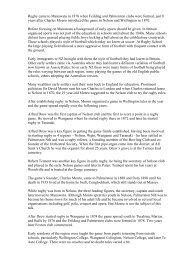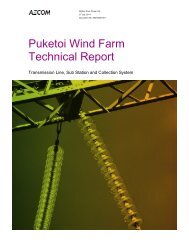Part 1 - Palmerston North City Council
Part 1 - Palmerston North City Council
Part 1 - Palmerston North City Council
You also want an ePaper? Increase the reach of your titles
YUMPU automatically turns print PDFs into web optimized ePapers that Google loves.
gemconsulting<br />
same as the upstream end of the rock lining) and will be constructed to a height that corresponds with the<br />
annual return flood level.<br />
Temporary Cofferdam<br />
A cofferdam will be constructed from the snub groyne to the temporary river channel to divert the river<br />
into the channel and thereby allowing construction of the rock lining to proceed in a flow free river bed. A<br />
further cofferdam will be constructed at the downstream end of the works to prevent water back‐flowing<br />
into the work area and to minimise sediment release form the works to the river.<br />
Rock Lining<br />
Rock linings generally provide protection against lateral erosion through the placement of rock directly<br />
against the lower sections of the river bank.<br />
In this instance the rock lining will be constructed away from the base of the cliff and will be reinforced by<br />
the gravel previously stockpiled in the middle of the river by placing it behind the rock lining as the work<br />
progresses. The lining will have a similar design to other rock linings already constructed within the <strong>City</strong><br />
Reach. It will be approximately 460 metres long. The rock lining will extend one metre below the level of<br />
the river bed when the works are complete with the upper level of the lining at a height corresponding with<br />
the annual return flood level. The lower part of the lining will be constructed with a median rock size of<br />
750kg and be 1.7 metres thick. Above this, the lining will be constructed with a median rock size of 300kg<br />
and will be 1.2 metres thick. The whole lining will have a 2:1 slope (26.6 degrees).<br />
The rock lining will be constructed to allow the unnamed tributary to enter the Manawatu River with the<br />
top part of the wall curving towards the stream as shown on Figure 1 (attached as Appendix B). The stream<br />
will be channelled across the gravel backfill and through this ‘gap’ in the rock lining.<br />
As mentioned, PMB Landco Ltd intends to re‐contour the western cliff. These works will see the cliff<br />
battered back to a slope starting from a point that leaves a seven metre wide bench on the rock lining to<br />
allow access for maintenance of the lining and for a possible future walkway connecting ANZAC Park to Pari<br />
Reserve. The lower part of the re‐contoured cliff will be lined with quarry rock to protect the fine soils from<br />
the cliff being eroded during floods that are higher than the annual return flood level.<br />
Bed Armouring<br />
Bed armouring layers consist of a few widely spaced larger rocks interspersed with smaller rocks. The larger<br />
rocks reduce the flow velocity close to the river bed thereby minimising scouring. The bed armouring<br />
concept has been successfully used in two locations within the <strong>City</strong> Reach; around the groynes at Fitzroy<br />
Bend and at the downstream end of the Katene Street rock lining.<br />
The new bed of the river will be armoured to prevent any scouring that may undermine the new rock lining.<br />
This armouring layer will be 500mm thick and consist of 80% reject quarry rock and 20% rock with a 300kg<br />
median weight.<br />
Gravel Recovery (if required)<br />
There is a risk that if a flood occurs during the construction period it could potentially wash stockpiled<br />
gravels downstream. If this occurs, recovery of these gravels will likely be required to ensure enough gravel<br />
is available to support the rock lining and complete the works.<br />
Tied Tree Works<br />
Once the rock lining is completed, the river bank upstream of the lining will be protected with tied tree<br />
works. The purpose of this activity is to prevent lateral erosion of the river bank and maintain river<br />
alignment, by providing relatively heavy vegetative protection, developing strong root systems, and<br />
encouraging the deposition of sediment at the toe of the banks. The works will involve anchoring live trees<br />
to the river bed and bank with wire ropes and anchors. Further tree planting will be carried out behind the<br />
tie tree works during the winter following construction.<br />
6


